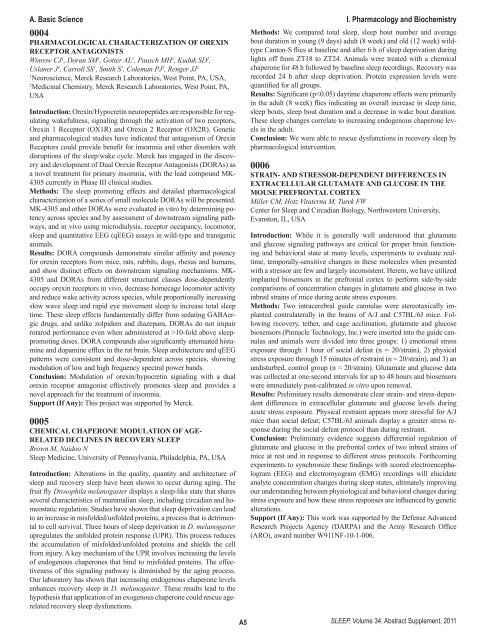SLEEP 2011 Abstract Supplement
SLEEP 2011 Abstract Supplement
SLEEP 2011 Abstract Supplement
You also want an ePaper? Increase the reach of your titles
YUMPU automatically turns print PDFs into web optimized ePapers that Google loves.
A. Basic Science I. Pharmacology and Biochemistry<br />
0004<br />
PHARMACOLOGICAL CHARACTERIZATION OF OREXIN<br />
RECEPTOR ANTAGONISTS<br />
Winrow CJ 1 , Doran SM 1 , Gotter AL 1 , Pausch MH 1 , Kuduk SD 2 ,<br />
Uslaner J 1 , Carroll SS 1 , Smith S 1 , Coleman PJ 2 , Renger JJ 1<br />
1<br />
Neuroscience, Merck Research Laboratories, West Point, PA, USA,<br />
2<br />
Medicinal Chemistry, Merck Research Laboratories, West Point, PA,<br />
USA<br />
Introduction: Orexin/Hypocretin neuropeptides are responsible for regulating<br />
wakefulness, signaling through the activation of two receptors,<br />
Orexin 1 Receptor (OX1R) and Orexin 2 Receptor (OX2R). Genetic<br />
and pharmacological studies have indicated that antagonism of Orexin<br />
Receptors could provide benefit for insomnia and other disorders with<br />
disruptions of the sleep/wake cycle. Merck has engaged in the discovery<br />
and development of Dual Orexin Receptor Antagonists (DORAs) as<br />
a novel treatment for primary insomnia, with the lead compound MK-<br />
4305 currently in Phase III clinical studies.<br />
Methods: The sleep promoting effects and detailed pharmacological<br />
characterization of a series of small molecule DORAs will be presented.<br />
MK-4305 and other DORAs were evaluated in vitro by determining potency<br />
across species and by assessment of downstream signaling pathways,<br />
and in vivo using microdialysis, receptor occupancy, locomotor,<br />
sleep and quantitative EEG (qEEG) assays in wild-type and transgenic<br />
animals.<br />
Results: DORA compounds demonstrate similar affinity and potency<br />
for orexin receptors from mice, rats, rabbits, dogs, rhesus and humans,<br />
and show distinct effects on downstream signaling mechanisms. MK-<br />
4305 and DORAs from different structural classes dose-dependently<br />
occupy orexin receptors in vivo, decrease homecage locomotor activity<br />
and reduce wake activity across species, while proportionally increasing<br />
slow wave sleep and rapid eye movement sleep to increase total sleep<br />
time. These sleep effects fundamentally differ from sedating GABAergic<br />
drugs, and unlike zolpidem and diazepam, DORAs do not impair<br />
rotarod performance even when administered at >10-fold above sleeppromoting<br />
doses. DORA compounds also significantly attenuated histamine<br />
and dopamine efflux in the rat brain. Sleep architecture and qEEG<br />
patterns were consistent and dose-dependent across species, showing<br />
modulation of low and high frequency spectral power bands.<br />
Conclusion: Modulation of orexin/hypocretin signaling with a dual<br />
orexin receptor antagonist effectively promotes sleep and provides a<br />
novel approach for the treatment of insomnia.<br />
Support (If Any): This project was supported by Merck.<br />
0005<br />
CHEMICAL CHAPERONE MODULATION OF AGE-<br />
RELATED DECLINES IN RECOVERY <strong>SLEEP</strong><br />
Brown M, Naidoo N<br />
Sleep Medicine, University of Pennsylvania, Philadelphia, PA, USA<br />
Introduction: Alterations in the quality, quantity and architecture of<br />
sleep and recovery sleep have been shown to occur during aging. The<br />
fruit fly Drosophila melanogaster displays a sleep-like state that shares<br />
several characteristics of mammalian sleep, including circadian and homeostatic<br />
regulation. Studies have shown that sleep deprivation can lead<br />
to an increase in misfolded/unfolded proteins, a process that is detrimental<br />
to cell survival. Three hours of sleep deprivation in D. melanogaster<br />
upregulates the unfolded protein response (UPR). This process reduces<br />
the accumulation of misfolded/unfolded proteins and shields the cell<br />
from injury. A key mechanism of the UPR involves increasing the levels<br />
of endogenous chaperones that bind to misfolded proteins. The effectiveness<br />
of this signaling pathway is diminished by the aging process.<br />
Our laboratory has shown that increasing endogenous chaperone levels<br />
enhances recovery sleep in D. melanogaster. These results lead to the<br />
hypothesis that application of an exogenous chaperone could rescue agerelated<br />
recovery sleep dysfunctions.<br />
Methods: We compared total sleep, sleep bout number and average<br />
bout duration in young (9 days) adult (8 week) and old (12 week) wildtype<br />
Canton-S flies at baseline and after 6 h of sleep deprivation during<br />
lights off from ZT18 to ZT24. Animals were treated with a chemical<br />
chaperone for 48 h followed by baseline sleep recordings. Recovery was<br />
recorded 24 h after sleep deprivation. Protein expression levels were<br />
quantified for all groups.<br />
Results: Significant (p

















